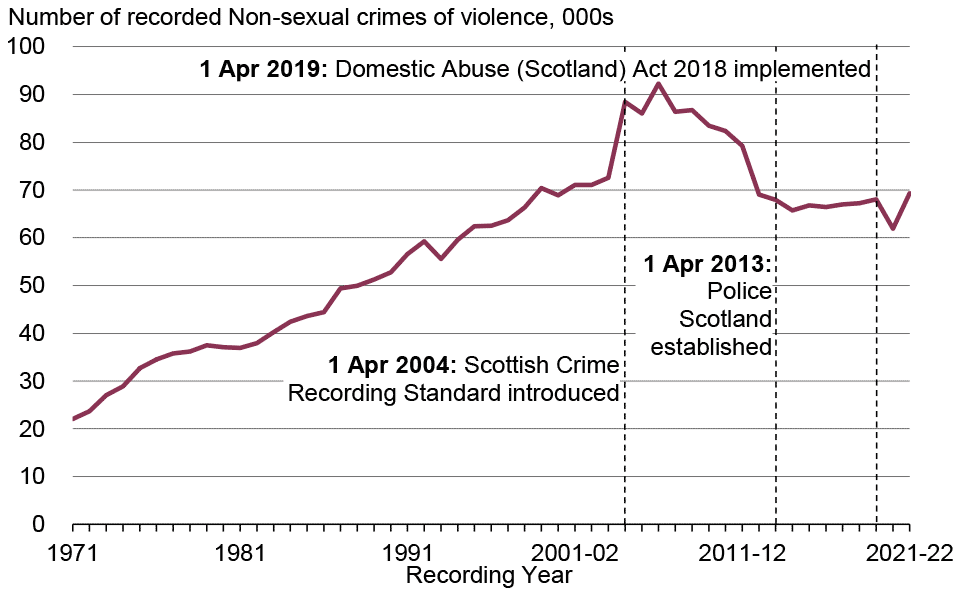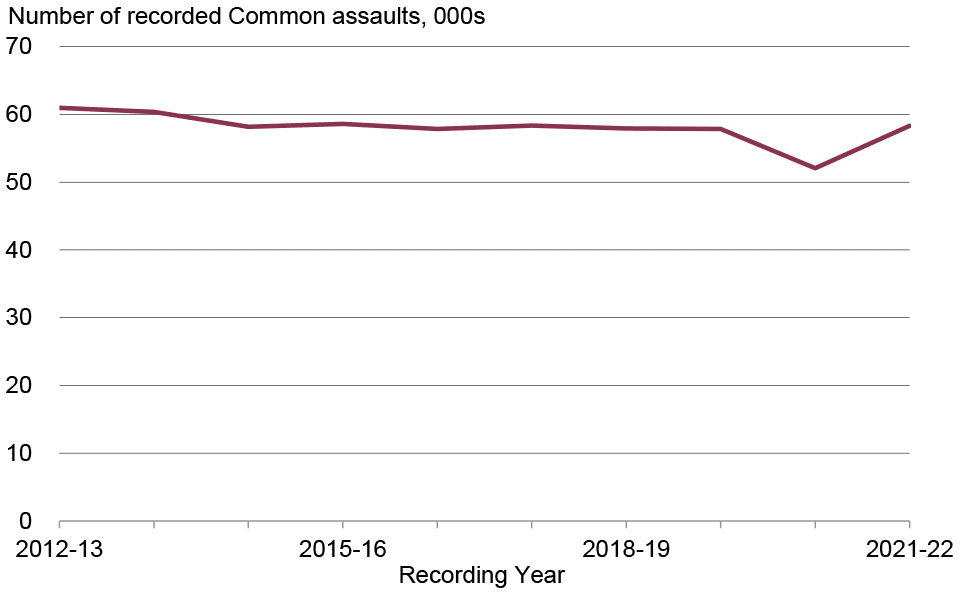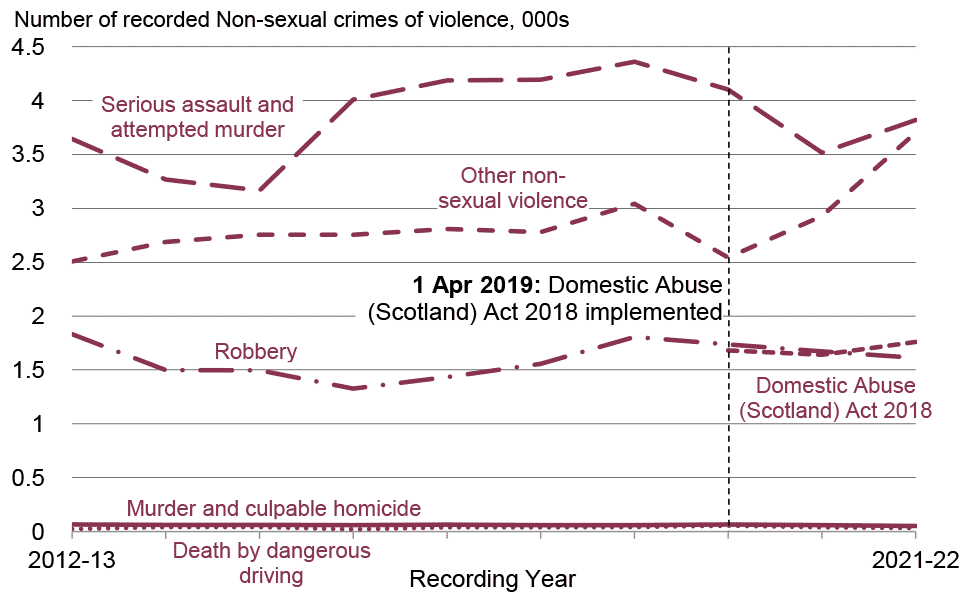Recorded Crime in Scotland, 2021-2022
Statistics on crimes and offences recorded and cleared up by the police in Scotland in 2021-22, split by crime or offence group and by local authority.
Non-sexual Crimes of Violence

The Non-sexual crimes of violence group has been greatly impacted by the new crime grouping structure, used for the first time in this year’s bulletin. This is due to Common assault and Stalking being reclassified as crimes rather than offences, and being included in this crime group. As noted above, this change has been back-revised within the statistics to maintain time series analysis.
Non-sexual crimes of violence accounted for almost a quarter (or 24%) of all crimes recorded in Scotland in 2021-22. Between 2020-21 and 2021-22, the number of Non-sexual crimes of violence recorded by the police in Scotland increased by 12%, from 61,913 to 69,286.
As a result of the new crime grouping structure, the clear majority (84% in 2021-22) of Non-sexual crimes of violence are now crimes of Common assault. Due to the size of this crime category within the group, any changes to the trend in Common assault will significantly impact the trend for the group as a whole. As such, the 12% increase in Non-sexual crimes of violence in this latest year, is primarily due to a 12% increase in Common assault.
This is the third year of new crimes being recorded within the Non-sexual crimes of violence group, under the Domestic Abuse (Scotland) Act 2018 – following its enactment on the 1 April 2019. There were 1,760 such crimes recorded in 2021-22, accounting for 3% of Non-sexual crimes of violence.
Chart 4 below shows the number of Non-sexual crimes of violence from 1971 onwards. Levels of violent crime increased for a long period, before entering a downward trend following a peak in 2006-07. There has been a 25% reduction in Non-sexual crimes of violence since 2006-07. Looking at the latest ten years, the number of Non-sexual crimes of violence has remained broadly stable (increasing by less than 1%), from 69,028 in 2012-13 to 69,286 in 2021-22.

Note: Data are incomplete for 1975 due to local government reorganisation.
The national rate of recorded Non-sexual crimes of violence increased from 113 to 127 crimes per 10,000 population between 2020-21 and 2021-22.
In 2021-22, of all Non-sexual crimes of violence:
- Common assault made up the vast majority, accounting for 84%
- Serious assault and attempted murder accounted for 6%
- Other non-sexual violence accounted for 5%
- Crimes under the Domestic Abuse (Scotland) Act 2018 accounted for 3%
- Robbery accounted for 2%
- Murder and culpable homicide and Causing death by dangerous driving both contributed very small proportions (both less than 0.5%) to the total
Chart 5 shows the number of Common assault crimes recorded over the latest ten years. This is presented separately from all other categories within Non-sexual crimes of violence due to the larger scale of crimes recorded in this category.
Chart 6 presents all other crime categories within Non-sexual crimes of violence over the latest ten years, and gives an indication of the trend and scale of each category.


The following sections discuss in more detail the trends for each crime category within the Non-sexual crimes of violence crime group. These are:
- Non-sexual crimes of violence
- Murder and culpable homicide
- Death by dangerous driving
- Serious assault and attempted murder
- Common assault
- Robbery
- Domestic Abuse (Scotland) Act 2018
- Other non-sexual violence
Further details for some categories can be found in the 'Supporting documents' Excel workbook.
Murder and culpable homicide
Murder and culpable homicide accounted for a very small proportion (less than 1%) of Non-sexual crimes of violence. Crimes recorded in this category decreased by 21% over the ten year period from 2012-13 to 2021-22. This includes a 15% decrease between 2020-21 and 2021-22, from 61 to 52 recorded crimes.
Data comparisons: Homicide in Scotland National Statistics
The Scottish Government produce a separate Homicide in Scotland statistics bulletin. It contains detailed information on the crimes of Murder and Culpable homicide (common law). It presents characteristics of victims and accused, such as age and gender and the circumstances of the homicide. Users interested in Homicide statistics should use the Homicide in Scotland statistics bulletin.
The latest bulletin reports on the year of 2020-21. The data showed a decrease in the number of homicide cases compared to 2019-20, from 65 to 55. This was the lowest number since comparable records began in 1976.
Death by dangerous driving
Causing Death by dangerous driving accounted for a very small proportion (less than 1%) of Non-sexual crimes of violence. Crimes recorded in this category increased by 36% over the ten year period from 2012-13 to 2021-22. However there has been a 13% decrease in the most recent year, from 39 crimes recorded in 2020-21 to 34 in 2021-22.
Serious assault and attempted murder
Serious assault and attempted murder accounted for 6% of Non-sexual crimes of violence. Crimes recorded in this category increased by 9% between 2020-21 and 2021-22, from 3,518 to 3,819. Over the ten year period from 2012-13 to 2021-22, this category has seen an increase of 5%, from 3,643 to 3,819.
These crimes fell between 2012-13 and 2014-15, before rising sharply in 2015-16 and then more gradually in the years that followed up to 2019-20. At least part of the increase in 2015-16 was attributed by Police Scotland to the introduction of enhanced guidance for recording Serious assault in January 2015. These crimes then fell over 2019-20 and 2020-21, before increasing again in 2021-22. The latest figure remains 12% lower than the peak in 2018-19.
For the definition of Serious assault and the distinction between Serious assault and Common assault please see Annex 1.
We previously published the findings of a more detailed study into Attempted murder & serious assault on our website.
One subset of the Serious assault and attempted murder category is the crime of Serious assault of retail worker, which came into effect on the 24 August 2021. This was introduced by the Protection of Workers (Retail and Age-restricted Goods and Services) (Scotland) Act 2021. As such, the first statistics for 2021-22 only relate to a partial year. There were eight crimes recorded during this time. More information on this new legislation is provided in Annex 3.
Data comparisons: Public Health Scotland Emergency Hospital Admissions as a result of Assault
Another source of statistics on assault is Public Health Scotland’s annual publication on hospital admissions due to unintentional injuries. This includes the number of emergency hospital admissions for assault.
The latest published figures are for 2020-21 and are available at: Unintentional injuries - Hospital Admissions: Year ending 31 March 2021 - Public Health Scotland
There are several reasons why direct comparisons cannot be made between the two sources. For example, not all who attend hospital with assault injuries will report what has happened to the police, and many recorded assaults will not require inpatient hospital treatment. However, as these sources both generally relate to how Scotland’s emergency services respond to the most serious types of assault, it would be anticipated that both should show similar trends over time.
Looking at the latest ten year period for which statistics are available from both sources, there were 1,891 emergency hospital admissions as a result of assault in 2020-21, of which 496 were due to assault with a sharp object and 1,412 were other assaults (including guns)[2]. This represents a 57% fall in the total number of emergency admissions due to assault since 2011-12, including a 47% reduction in emergency admissions due to assault with a sharp object. This comparison confirms that the reduction in police recorded crimes of serious assault and attempted murder between 2011-12 and 2020-21 (by 25% from 4,693 to 3,518) has also been broadly reflected in statistics for emergency admissions to hospital. Whilst the reduction in admissions is larger than that for recorded crime, the change in guidance for crimes classed as serious assaults in 2015 may have had an impact on these figures.
Common assault
As discussed above, Common assault has been reclassified as a crime under the Non-sexual crimes of violence group. As a result, Common assault is now the largest category of Non-sexual crimes of violence, accounting for 84% in 2021-22. Over the ten year period from 2012-13 to 2021-22, the number of crimes recorded in this category has fallen by 4%. However, there was a 12% increase between 2020-21 and 2021-22 (from 52,052 to 58,306). This reversed the reduction seen in 2020-21, which itself may have been due to the impact of the COVID-19 pandemic, and associated measures to limit social contact.
Of the 58,306 crimes recorded in 2021-22, 7,858 (13%) related to Common assault of emergency workers, a decrease of 3% since 2020-21 and an increase of 21% since 2012-13. Another subset of the Common assault category is the crime of Common assault of retail worker. 786 crimes (1% of all Common assault) related to Common assault of retail workers. As noted in the Introduction, the crime of Common assault of retail worker came into effect on the 24 August 2021. This was introduced by the Protection of Workers (Retail and Age-restricted Goods and Services) (Scotland) Act 2021. As such, the first statistics for 2021-22 only relate to a partial year. More information on this new legislation is provided in Annex 3.
Robbery
Robbery accounted for 2% of Non-sexual crimes of violence. Over the ten year period from 2012-13 to 2021-22, this category has seen a decrease of 12%. Following increases between 2016-17 and 2018-19, there have been decreases for the past three years. There was a 4% decrease between 2020-21 and 2021-22 (from 1,673 to 1,613).
We previously published the findings of a more detailed study into Robbery. Further information is available on our website.
Domestic Abuse (Scotland) Act 2018
Crimes recorded under the Domestic Abuse (Scotland) Act 2018 accounted for 3% of Non-sexual crimes of violence. There were 1,760 crimes recorded under the Domestic Abuse (Scotland) Act 2018 in 2021-22, the third year this legislation has been in place. This was a 7% increase compared to 2020-21 (from 1,641 to 1,760).
Of those crimes, 92% (or 1,627) involved a female victim and 8% (or 133) had a male victim. These proportions are similar to those in the previous year, at 94% and 6%, respectively.
It should be noted that crimes under the Domestic Abuse (Scotland) Act 2018 relate to a course of conduct only and therefore do not include all crimes relating to domestic abuse.
Annex 2 provides information on the results of HMICS Crime Audit 2020, which also examined a sample of incidents relating to domestic abuse.
Data comparisons: Official Statistics on Domestic Abuse recorded by the police in Scotland
Statistic presented in this bulletin are the primary source for users interested in the number of crimes recorded under the Domestic Abuse (Scotland) Act 2018.
However, separate analysis of domestic abuse incidents reported to the police, is presented in the Domestic abuse: statistics recorded by the police in Scotland Official Statistics bulletin. This is produced by the Scottish Government and contains details of domestic abuse incidents and crimes recorded by Police Scotland, including characteristics of victims and perpetrators, such as their age and gender.
The next Domestic abuse recorded by the police in Scotland bulletin will contain data for 2021-22 and will be published in November 2022.
Other non-sexual violence
The Other non-sexual violence category has been impacted by the new crime grouping structure. Stalking has been added to this category with the change back-revised in the data to maintain time series analysis (it was previously classified as an offence in the Miscellaneous offences group).
The Other non-sexual violence category includes a wide range of crime types, albeit just five accounted for 94% of the 3,702 crimes recorded in 2021-22. This included Threats & extortion (38% of all Other non-sexual crimes), Stalking (23%), Cruelty to & unnatural treatment of children (15%), Drugging (12%) and Abduction (7%). More detail on the crimes included is provided in the User Guide.
Crimes recorded as Other non-sexual violence accounted for 5% of Non-sexual crimes of violence in 2021-22. Over the ten year period from 2012-13 to 2021-22 this category has seen an increase of 48%, including an increase of 26% from 2,929 in 2020-21 to 3,702 in 2021-22
The 26% increase in 2021-22 was primarily due to increases in crimes of Drugging (from 18 in 2020-21 to 444 in 2021-22) and Threats & extortion (from 946 in 2020-21 to 1,398 in 2021-22). The Monthly Official Statistics on recorded crime showed that the increase in Drugging was not evenly spread across the year – it began in October and peaked in November. After this there was a downward trend. The increase in recorded crimes of Drugging may be at least in part due to the significant coverage on national and social media of the issue of spiking during the autumn of 2021.
Ninety percent of crimes of Threats and extortion were estimated to be cyber-crimes in 2021-22 (further information on this is available in the Cyber-crime chapter).
Contact
Email: Justice_Analysts@gov.scot
There is a problem
Thanks for your feedback